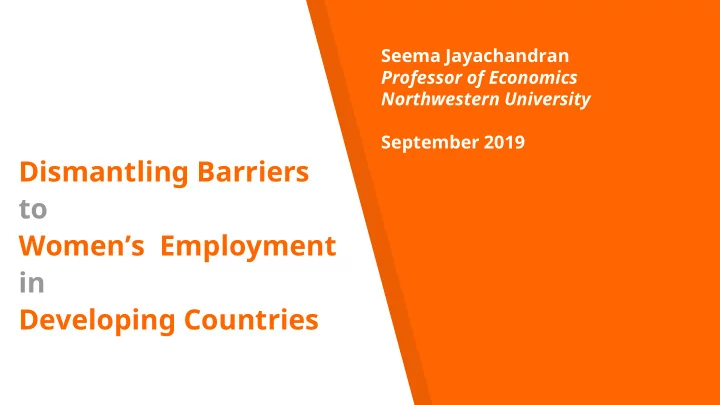

Seema Jayachandran Professor of Economics Northwestern University September 2019 Dismantling Barriers to Women’s Employment in Developing Countries
Overview ▸ What is the connection between economic development and gender equality? ▸ How do cultural norms limit women’s employment and equality? ▸ What policies can help dismantle barriers to women’s employment?
Women earn less than men around the world US data
Economic progress can narrow gender gaps in the labor market
Economic progress can narrow gender gaps in the labor market
Economic progress can narrow gender gaps in the labor market
Economic progress can narrow gender gaps in the labor market
Economic progress can narrow gender gaps in the labor market
Scope for public policies and programs to speed up progress ▸ Piped water, electrification, affordable appliances ▸ Expansion of pre-primary education ▸ Subsidized child care ▸ Affordable family planning services
But female employment rate falls over some range of economic development
Attitudes about female employment appear worse in poor countries “
Gender norms differ across cultures and matter for female employment
Low participation of women in the workforce in South Asia and MENA 27% INDIA
New Delhi, India
Very few women
Ways to promote female employment in India: 3 attempts Strengthen the peer networks of women 1. entrepreneurs Tell family members about the benefits and 2. dispel myths about the costs of letting young women work Change the deep-seated gender attitudes 3. of adolescents
Example 1: Strengthen women’s business networks ▸ Female-owned businesses often stay small and not-too-profitable ▸ Women face disadvantages due to less formal training + sparse network of peers
Randomized experiments INTERVENTION Population is randomly Outcomes for both split into two groups groups are measured CONTROL = Struggling business = Successful business
Example 1: Strengthen women’s business networks Offered business training course Self-employed Offered business women in training course + Ahmedabad, could invite a peer India to attend Control group
Example 1: Strengthen women’s business networks Women in India Who Trained with a Friend Were More Likely to Take Out a Loan Offered business PERCENT OF WOMEN WHO TOOK OUT A SEWA training course LOAN USINESS 15% Self-employed Offered business women in training course + 8% 6% Ahmedabad, could invite a peer India to attend Not invited Invited to Invited to training to training training alone with friend Control group SOURCE “ FRIENDS AT WORK: CAN PEER SUPPORT STIMULATE FEMALE ENTREPRENEURSHIP? ” ERICA FIELD ET AL., 2014
Two-fold objective of research ▸ “Applied research”: Measure the impact that a specific policy has on outcome of interest ▸ “Basic research”: Understand the economic and cultural forces that underlie the problem → New ideas for potential policies
Example 2: Change family members’ views ▸ Men often discourage or prevent their daughters or wives from working ▸ Women discourage female employment too ▸ Concerns about personal safety and “purity” ▸ Also might under-appreciate the positive effects, e.g., self-efficacy, of working
Testimonials from teachers & family members
Example 2: Change male family members’ views Family members shown video about safety and/or self-realization benefits of women working Prompted conversation Kindergarten among family members teachers in about risks and benefits of rural India working Control group
Results ▸ No impacts on attitudes or outcomes related to female employment
Example 3: Change adolescents’ attitudes ▸ Belief that women are ill-suited for employment or that it is wrong for women to work is embedded in the culture ▸ Transformative change requires reshaping those attitudes and social norms
Example 3: Change adolescents’ attitudes Class discussions about gender discrimination High school students Control group
Session on household chores ▸ Students asked to identify who does various chores in their house, e.g., cooking ▸ Share their answers with class and notice pattern that women/girls do more chores ▸ Discuss why that is and whether it is fair ▸ Who does similar tasks outside the home, e.g., cooks in restaurants? ▸ Does society value both activities equally?
Results: More support for gender equality Classroom Discussions of Gender Equality Led to More Progressive Gender Attitudes Class Classroom Discussions of Gender Equality Led to More STANDARD DEVIATIONS OF ATTITUDE DISTRIBUTION Progressive Gender Attitudes discussions STAND ANDAR ARD DEVI VIAT ATIONS NS OF ATTITUDE DIST STRI RIBUT BUTION about gender 0,69 discrimination High school students 0,25 0,14 Control group Treatment effect Parent attitude Girl-boy attitude XXX gap gap SOURCE “RESHAPING ADOLESCENTS’ GENDER ATTITUDES: EVIDENCE FROM A SCHOOL -BASED EXPERIMENT IN INDIA,” DHAR ET AL., 2018
Next steps: Further testing and scaling up ▸ Breakthrough has trained other non-profits to implement the curriculum ▸ Government could hire special-purpose government teachers ▸ Textbooks + standardized assignments
Next steps: Measuring long-term effects ▸ More female employment? ▸ Equal investment in sons & daughters? ▸ More daughters to begin with, i.e., less sex- selective abortion?
Examples of other policies to promote women’s employment ▸ Bicycles for girls to use to travel to school ▸ Women’s subway cars or buses for safer commutes ▸ Women’s police stations
Other norms besides safety and “purity” need to be addressed ▸ Control over household finances ▹ Bank accounts for women increased female participation in workfare program ▸ Backlash by men if their wives are the breadwinners ▹ Role of interventions to prevent IPV ▸ Men’s role in child care and housework
Closing these gaps matters ▸ Not using women’s talents leaves money on the table ▸ When women earn more – and hence have more say in the household – evidence suggests children’s outcomes improve ▸ Equity is important in and of itself
Thank you
But there has been progress over time “
Many important gender gaps are larger in poorer countries “
Recommend
More recommend